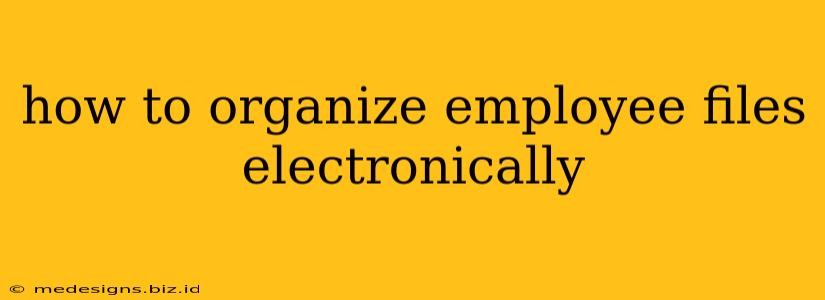Maintaining accurate and easily accessible employee files is crucial for any business, regardless of size. Transitioning to electronic employee file management offers significant advantages, including improved security, streamlined workflows, and reduced storage costs. However, simply digitizing paper files isn't enough; effective organization is key. This guide will walk you through best practices for organizing employee files electronically, ensuring compliance and efficiency.
Choosing the Right System
Before diving into organization, you need the right tools. Consider these options:
-
Cloud-Based Storage: Services like Google Drive, Dropbox, and Microsoft OneDrive offer secure, accessible storage with collaboration features. They're ideal for smaller businesses or those already using these platforms. Security features such as two-factor authentication are paramount.
-
Dedicated HR Software: Solutions like BambooHR, Gusto, and ADP offer integrated HR functionalities, including employee file management. They often include features for managing payroll, benefits, and performance reviews, making them a comprehensive solution for larger companies.
-
Enterprise Content Management (ECM) Systems: For large organizations with complex needs, ECM systems provide robust features for document management, workflow automation, and compliance.
Choosing the right system depends on your budget, company size, and specific needs. Consider factors like security, scalability, integration with existing systems, and user-friendliness.
Establishing a Consistent Filing Structure
A well-defined filing structure is essential for easy retrieval of information. Here's a recommended approach:
1. Employee Identification:
Use a consistent naming convention for each employee's folder. Avoid using personal information like social security numbers directly in the file name. Instead, use employee ID numbers or a combination of last name and initials. For example: EmployeeID_1234 or Smith_J_Files.
2. Categorizing Documents:
Organize documents within each employee folder using subfolders. Common categories include:
- Application & Onboarding: Resumes, cover letters, offer letters, background checks, I-9 forms.
- Personal Information: Addresses, emergency contacts, tax information (ensure compliance with privacy regulations).
- Payroll & Compensation: Pay stubs, W-2s, benefit enrollment forms.
- Performance Reviews: Performance evaluations, reviews, and goal setting documents.
- Training & Development: Records of completed training courses and certifications.
- Disciplinary Actions: Documentation of any disciplinary actions, warnings, or performance improvement plans.
- Benefits: Health insurance, retirement plan documents, other benefit related paperwork.
- Separation of Employment: Resignation letters, exit interviews, final pay stubs.
3. Document Naming Conventions:
Use clear and descriptive file names. Avoid using ambiguous names like "Document1" or "File2." Instead, use descriptive names like "Performance Review_2023-10-26" or "Benefits Enrollment Form_2024." Using dates is helpful for easy sorting and retrieval.
Maintaining Data Security and Compliance
Protecting employee data is paramount. Implement these security measures:
- Access Control: Limit access to employee files based on roles and responsibilities. Only authorized personnel should have access to sensitive information.
- Data Encryption: Encrypt sensitive data both in transit and at rest to prevent unauthorized access.
- Regular Backups: Regularly back up your employee files to a secure offsite location.
- Compliance: Understand and comply with all relevant data privacy regulations (e.g., GDPR, CCPA). Familiarize yourself with local and federal laws regarding data security and employee records.
Regularly Reviewing and Archiving
Regularly review your electronic filing system. Delete unnecessary files and archive older documents according to your company’s retention policies. This will keep your system organized and efficient. Establish a clear archiving process to ensure compliance and efficient information retrieval.
By following these steps, you can establish a robust and compliant electronic employee file management system that improves efficiency and protects sensitive information. Remember to consistently review and update your system as your company grows and regulatory requirements evolve.
